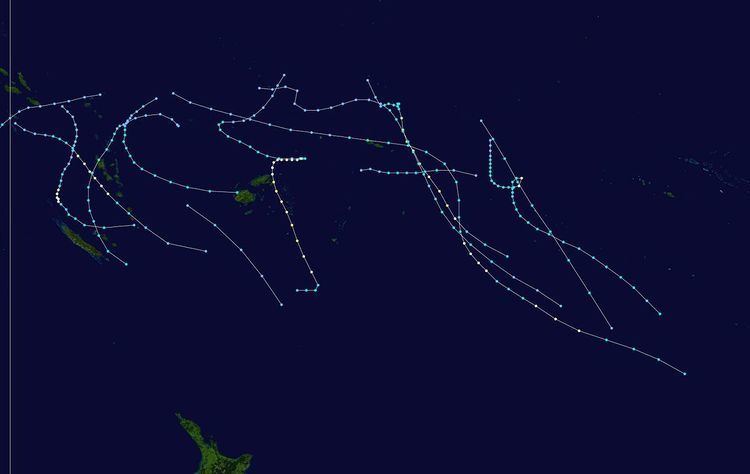First system formed November 20, 1986 Name Uma Tropical cyclones 12 | Last system dissipated May 22, 1987 Total depressions 13 Severe tropical cyclones 5 | |
 | ||
The 1986–87 South Pacific cyclone season was an event in the annual cycle of tropical cyclone formation. A total of 13 tropical cyclones developed during the season.
Contents
- Tropical Cyclone Osea
- Tropical Cyclone Patsy
- Severe Tropical Cyclone Raja
- Severe Tropical Cyclone Sally
- Severe Tropical Cyclone Tusi
- Severe Tropical Cyclone Uma
- Tropical Cyclone Veli
- Severe Tropical Cyclone Wini
- Severe Tropical Cyclone Yali
- Tropical Cyclone Zuman
- Tropical Cyclone Blanche
- Other systems
- References
During the season twelve tropical cyclones were recorded within the South Pacific basin, which was considered above average when compared to an 18-year average of 10 systems.
Tropical Cyclone Osea
Tropical Cyclone Osea formed about 565 km (350 mi) to the north-northeast of Port Vila on 21 November. It moved on a southerly track parallel to Vanuatu and spent most of its time over the sea. No significant damage was reported.
Tropical Cyclone Patsy
On December 12, TCWC Nadi started to monitor a tropical depression that had developed about 1,000 km (620 mi) to the north-northwest of Suva, Fiji.
The system affected Northern Vanuatu but caused little or no damage to the island nation.
Severe Tropical Cyclone Raja
Cyclone Raja existed from December 21, 1986, to January 5, 1987.
Severe Tropical Cyclone Sally
Cyclone Sally existed from December 26, 1986, to January 6, 1987.
Severe Tropical Cyclone Tusi
On January 13, TCWC Nadi started to monitor a tropical depression that had developed, within a trough of low pressure near the island nation of Tuvalu. Over the next few days the system gradually developed further before it was named Tusi during January 16, after it had become equivalent to a modern-day category 1 tropical cyclone on the Australian tropical cyclone intensity scale. After being named the system gradually intensified as it moved southeastwards along the trough, between the islands of Fakaofo and Swains during January 17. Tusi's eye subsequently passed near or over American Samoa's Manu'a Islands early the next day, as the system peaked in intensity with 10-minute sustained wind speeds of 150 km/h (90 mph). The system subsequently posed a threat to the Southern Cook Islands, however this threat gradually diminished as Tusi moved southwards and approached 25S during January 20.
Severe Tropical Cyclone Uma
Cyclone Uma existed from February 4 to February 10.
Tropical Cyclone Veli
The precursor tropical low to Cyclone Veli formed within the Australian region on February 5, about 725 km (450 mi) to the south-east of Port Moresby in Papua New Guinea. During the next day the low moved eastwards and gradually developed further, before it became equivalent to a category 1 tropical cyclone on the Australian scale, as it reached its 10-minute sustained wind speeds of 85 km/h (55 mph). As the system continued to move eastwards it crossed 160°E and moved into the South Pacific basin during February 7, before the FMS named it Veli later that day on the basis of satellite derived evidence. During that day the system continued to move eastwards, before as it passed near to Espitru Santo, Veli started to move steadily towards the south-east. Early the next day the JTWC initiated advisories and started to monitor Veli as Tropical Cyclone 16P, with peak 1-minute sustained windspeeds of 45 km/h (30 mph). During that day strong upper level north-westerlies caused vertical windshear to increase over Cyclones Veli and Uma and thus weakened them. During February 9, Cyclone Veli absorbed Uma and formed a complex low, which moved slowly south-eastwards and became extratropical. Damage within Vanautu was either minimal or went unreported, as the island nation was more concerned with the aftermath of Cyclone Uma.
Severe Tropical Cyclone Wini
Cyclone Wini existed from February 27 to March 7.
Severe Tropical Cyclone Yali
A shallow tropical depression developed within a monsoon trough of low pressure during March 5, about 485 km (300 mi) to the southeast of Honiara, on the Solomon Island of Guadalcanal. Over the next 3 days the system remained as a shallow depression as it moved southwards, before it rapidly developed into a tropical cyclone underneath an upper level ridge of high pressure. During March 8, the JTWC classified the system as Tropical Cyclone 22P and initiated advisories on the system, while it was named Yali by the FMS after it had developed into a Category 1 tropical cyclone on the Australian scale. During the next day Yali continued to intensify before as the ridge of high pressure moved northwards, before the system peaked with 1 and 10-minute sustained windspeeds of 120 km/h (75 mph). This made it a category 3 severe tropical cyclone on the Australian tropical cyclone intensity scale and equivalent to a category 1 hurricane on the Saffir-Simpson hurricane scale. During the next day Yali rapidly weakened and dissipated over water during March 11. Despite being within the vicinity of both Vanuatu and New Caledonia, the system did not pass close enough to affect or cause any damage to any inhabited islands.
Tropical Cyclone Zuman
Cyclone Zuman existed from April 19 to April 26.
Tropical Cyclone Blanch(e)
On May 20, TCWC Nadi started to monitor a tropical depression that had developed about 1,440 km (895 mi) to the northeast of Port Villa, Vanuatu.
Other systems
In addition 12 cyclone, two other systems developed during the season. Cyclone 13P existed from February 2 to February 5. Another system, 19P, existed from February 28 to March 2.
